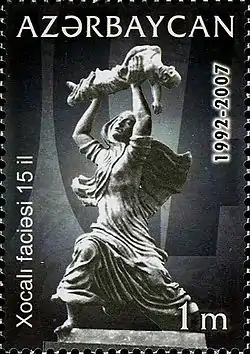Khojaly Genocide Day
The Khojaly Genocide Day (Azerbaijani: Xocalı soyqırımı günü, Xocalı genosidi günü),[1][2] or the Day of the Khojaly Genocide and National Mourning (Azerbaijani: Xocalı soyqırımı və milli matəm günü),[3][4] is a public holiday in Azerbaijan commemorated on 26 February every year for mourning the civilians killed in the Khojaly massacre,[5] referred to in Azerbaijan as genocide.[6]
| Khojaly Genocide Day | |
|---|---|
 An Azerbaijani postage stamp issued in 2007 on the 15th anniversary of the massacre | |
| Official name | Azerbaijani: Xocalı soyqırımı günü |
| Also called | Day of Khojaly Genocide and National Mourning |
| Observed by | Azerbaijan |
| Type | National |
| Significance | for mourning the civilians killed in the Khojaly massacre |
| Date | 26 February |
| Next time | 26 February 2021 |
| Frequency | Annual |
| Related to | Khojaly massacre |
The Khojaly massacre was described by Human Rights Watch as "the largest massacre to date in the conflict" over Nagorno-Karabakh.[7] A 1994 report by Human Rights Watch put the number of deaths at least 200, while adding that as many as 500–1,000 people may have died.[7] Initially, the Azerbaijani parliament was able to identify 485 people as the victims of the massacre,[8] but later official figures stated that 613 civilians were killed.[9]
History
Background
On 26 February 1992, during the First Nagorno-Karabakh War, Armenian Armed Forces and 366th CIS regiment massacred as high as 613 ethnic Azerbaijani civilians in the town of Khojaly. This incident was known as the Khojaly massacre.[8][10][11] Although the Azerbaijani sources[12][13] occasionally refer to the massacre as a genocide (Azerbaijani: Xocalı soyqırımı) or a tragedy (Xocalı faciəsi),[6] the Western governments and media uses "Khojaly massacre" to refer to the incident.[14]
The Khojaly massacre was described by Human Rights Watch as "the largest massacre to date in the conflict" over Nagorno-Karabakh.[7] A 1993 report by Human Rights Watch put the number of deaths at least 161,[15] although later reports state the number of deaths as at least 200. According to Human Rights Watch, "while it is widely accepted that 200 Azeris were murdered, as many as 500–1,000 may have died".[7] Initially, the Azerbaijani parliament was able to identify 485 people as the victims of the massacre,[8] but later official figures stated that 613 civilians were killed.[9]
Institution
On 24 February 1994, the National Assembly of Azerbaijan issued to declare 26 February as the "day of mourning for the victims of the Khojaly events, one of the national tragedies of the Azerbaijani people and one of the bloodiest pages in human history."[5] On 25 February 1997, the President of Azerbaijan, Heydar Aliyev, issued a decree to declare a moment of silence in memory of the victims of the Khojaly massacre.[16]
References
- "Xocalı faciəsindən 26 il ötür". Azerbaijan State News Agency (in Azerbaijani). 26 February 2018. Retrieved 6 December 2020.
- "Bloody Memory". President.az. Presidential Administration of Azerbaijan. Retrieved 6 December 2020.
- "Unforgettable dates". Mehriban-aliyeva.az. Retrieved 6 December 2020.
- "XOCALI SOYQIRIMI". Supreme Court of Azerbaijan (in Azerbaijani). Retrieved 6 December 2020.
- ""Xocalı soyqırımı (genosidi) günü haqqında" Azərbaycan Respublikası Milli Məclisinin 24 fevral 1994-cü il tarixli, 791 nömrəli Qərarı". e-qanun.az (in Azerbaijani). 24 February 1994. Retrieved 6 December 2020.
- "State Commission on prisoners of war, hostages and missing persons – Khojaly genocide". Human.gov.az. Archived from the original on 1 November 2012. Retrieved 6 December 2020.
- Human Rights Watch/Helsinki (1994). Azerbaijan: Seven Years of Conflict in Nagorno-Karabakh. New York [u.a.]: Human Rights Watch. p. 6. ISBN 1-56432-142-8. Retrieved 6 December 2020.
- de Waal, Thomas (2004). Black garden: Armenia and Azerbaijan through peace and war. ABC-CLIO. pp. 172–173. ISBN 0-8147-1945-7. Archived from the original on 3 June 2016.
- Letter dated 26 February 2015 from the Permanent Representative of the Republic of Azerbaijan to the United Nations Office at Geneva addressed to the President of the Human Rights Council Archived 11 January 2016 at the Wayback Machine
- "New York Times – massacre by Armenians Being Reported". Commonwealth of Independent States; Azerbaijan; Khojaly (Armenia); Armenia: Select.nytimes.com. 3 March 1992. Archived from the original on 11 March 2007. Retrieved 6 December 2020.
- Smolowe, Jill (16 March 1992). "TIME Magazine – Tragedy Massacre in Khojaly". Time.com. Archived from the original on 28 February 2005. Retrieved 6 December 2020.
- Archived 3 March 2011 at the Wayback Machine
- "Welcome". Hocalisoykirimi.com. Archived from the original on 23 July 2013. Retrieved 6 December 2020.
- "Armenians Gain in New Battle With Azerbaijanis". New York Times. 27 February 1992. Archived from the original on 30 March 2014. Retrieved 6 December 2020.
- "Human Rights Watch World Report 1993 – The Former Soviet Union". Hrw.org. Archived from the original on 18 February 2015. Retrieved 6 December 2020.
- "Посольство Азербайджанской Республики в Республике Беларусь — Ходжалинская трагедия" (in Belarusian). Archived from the original on 23 September 2013. Retrieved 6 December 2020.